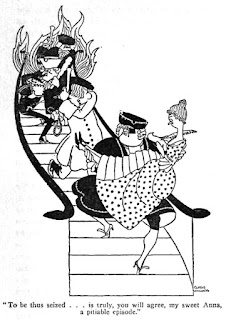THE RETAIL MERCHANTS’ ASSOCIATION ought to buy up all the copies of “Elements of Retail Salesmanship,” by Paul Westley Ivey (Macmillan), and not let a single one get into the hands of a customer, for once the buying public reads what is written there the game is up. It tells all about how to sell goods to people, how to appeal to their weaknesses, how to exert subtle influences which will win them over in spite of themselves. Houdini might as well issue a pamphlet giving in detail his methods of escape as for the merchants of this country to let this book remain in circulation.
 |
| "They intimate that I had better take my few pennies and run 'round the corner to some little haberdashery." Drawing by Gluyas Williams |
It is reassuring to know that it is a recognized ruse on the part of the salesman to intimate that unless you buy a particular article you will have to totter through life branded as the arch-piker. I have always taken this attitude of the clerks perfectly seriously. In fact, I have worried quite a bit about it.
In the store where I am allowed to buy my clothes it is quite the thing among the salesmen to see which one of them can degrade me most. They intimate that, while they have no legal means of refusing to sell their goods to me, it really would be much more in keeping with things if I were to take the few pennies that I have at my disposal and run around the corner to some little haberdashery for my shirts and ties. Every time I come out from that store I feel like Ethel Barrymore in “Déclassée.” Much worse, in fact, for I haven’t any good looks to fall back upon.






































